The Evolution Of Zwilling Since 1731
Zwilling, a name synonymous with high-quality kitchenware, has a storied history that dates back to 1731. Founded in Solingen, Germany, the brand has evolved significantly over the centuries, adapting to the changing needs of cooks and chefs around the globe. This article explores the remarkable journey of Zwilling, highlighting its founding principles, early craftsmanship, global expansion, and modern-day commitment to quality.
The Founding of Zwilling: A Legacy Begins in 1731
In 1731, Peter Henckels established Zwilling J.A. Henckels in Solingen, a city known for its blade production. The brand’s name, "Zwilling," which means "twin" in German, was inspired by the twin logo that represents the company’s commitment to quality and craftsmanship. From the outset, Zwilling focused on producing high-quality knives, quickly gaining a reputation for excellence in design and functionality.
The early years of Zwilling were marked by meticulous attention to detail and a dedication to traditional manufacturing techniques. The company initially produced forged knives that were durable and efficient, appealing to both professional chefs and home cooks. As the demand for kitchen tools grew, Zwilling expanded its product range, incorporating innovative designs while maintaining its commitment to high-quality materials.
By the end of the 18th century, Zwilling had established itself as a leading brand in the knife-making industry. The company received numerous awards for its products, solidifying its reputation as a symbol of quality in culinary tools. This early recognition set the stage for the brand’s enduring legacy, as it continued to build on its heritage of craftsmanship and innovation.
Craftsmanship and Innovation: Zwilling’s Early Years
As Zwilling progressed into the 19th century, the company embraced innovation while staying true to its roots in craftsmanship. The industrial revolution brought advancements in manufacturing processes, allowing the brand to scale production without compromising quality. Zwilling began to incorporate modern technologies, such as steam-powered machinery, which improved efficiency and consistency in their products.
During this period, Zwilling also focused on expanding its product line beyond knives. The brand began offering a variety of kitchen tools, including cookware and cutlery accessories. This diversification not only catered to the growing culinary market but also established Zwilling as a comprehensive provider of kitchen essentials. Each new product was designed with the same attention to detail and quality that had defined the brand from the beginning.
The commitment to craftsmanship remained unwavering, even as the company adopted new technologies. Zwilling continued to employ skilled artisans who used traditional methods to create knives that were not only functional but also beautifully crafted. This blend of tradition and innovation allowed Zwilling to maintain its status as a leader in the culinary world, setting the foundation for its future success.
Expanding the Brand: Zwilling’s Global Reach and Impact
In the late 19th and early 20th centuries, Zwilling began to expand its presence beyond Germany. The brand recognized the growing global interest in culinary arts and sought to reach international markets. Through strategic partnerships and distribution agreements, Zwilling successfully introduced its products to various countries, including the United States and Japan.
The expansion coincided with a surge in culinary interest and the rise of professional chefs. Zwilling’s high-quality products became essential tools in both home kitchens and professional culinary schools. The brand’s reputation for excellence attracted chefs from diverse culinary traditions, further solidifying Zwilling’s status as a global leader in kitchenware.
Zwilling’s commitment to quality and innovation resonated with culinary enthusiasts worldwide. The brand not only provided tools but also fostered a community of passionate cooks. Through cooking classes, workshops, and collaborations with culinary schools, Zwilling established itself as more than just a manufacturer; it became a vital part of the culinary education and experience.
The Modern Era: Zwilling’s Commitment to Quality Today
In the contemporary culinary landscape, Zwilling continues to uphold its legacy of quality and innovation. The brand has embraced modern design trends while utilizing advanced materials and techniques to enhance performance. Zwilling knives, cookware, and kitchen gadgets are designed to meet the needs of today’s diverse cooking styles, ensuring that both amateur cooks and professional chefs can enjoy the best cooking experience.
Sustainability has also become a focal point for Zwilling in recent years. The company has implemented environmentally friendly practices in its manufacturing processes, such as reducing waste and utilizing recycled materials. This commitment to sustainability not only reflects the brand’s responsibility to the planet but also resonates with consumers who are increasingly seeking eco-friendly options in their kitchenware.
Furthermore, Zwilling has expanded its product offerings to include smart kitchen tools that integrate technology into cooking. From smart thermometers to app-connected kitchen gadgets, Zwilling is at the forefront of culinary innovation. This evolution demonstrates the brand’s ability to adapt to changing consumer preferences while maintaining its core values of quality and craftsmanship.
The evolution of Zwilling since 1731 is a testament to the brand’s unwavering commitment to quality, innovation, and craftsmanship. From its humble beginnings in Solingen to its status as a global leader in kitchenware, Zwilling has continually adapted to meet the needs of cooks around the world. As the culinary landscape continues to evolve, Zwilling remains dedicated to providing high-quality tools that empower culinary creativity, ensuring that its legacy endures for generations to come.
